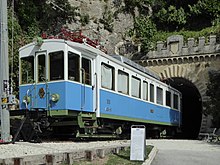Rimini – San Marino railway line
| San Marino – Rimini | |||||||||||||||||||||||||||||||||||||||||||||||||||||||||||||||||||||||||||||||||||||||||||||||||||||||||||||||||||||||||||||||||||||||||||||||||||||||||
|---|---|---|---|---|---|---|---|---|---|---|---|---|---|---|---|---|---|---|---|---|---|---|---|---|---|---|---|---|---|---|---|---|---|---|---|---|---|---|---|---|---|---|---|---|---|---|---|---|---|---|---|---|---|---|---|---|---|---|---|---|---|---|---|---|---|---|---|---|---|---|---|---|---|---|---|---|---|---|---|---|---|---|---|---|---|---|---|---|---|---|---|---|---|---|---|---|---|---|---|---|---|---|---|---|---|---|---|---|---|---|---|---|---|---|---|---|---|---|---|---|---|---|---|---|---|---|---|---|---|---|---|---|---|---|---|---|---|---|---|---|---|---|---|---|---|---|---|---|---|---|---|---|---|
| Route length: | 31.5 km | ||||||||||||||||||||||||||||||||||||||||||||||||||||||||||||||||||||||||||||||||||||||||||||||||||||||||||||||||||||||||||||||||||||||||||||||||||||||||
| Gauge : | 950 mm ( Italian meter gauge ) | ||||||||||||||||||||||||||||||||||||||||||||||||||||||||||||||||||||||||||||||||||||||||||||||||||||||||||||||||||||||||||||||||||||||||||||||||||||||||
| Power system : | 3000 V = | ||||||||||||||||||||||||||||||||||||||||||||||||||||||||||||||||||||||||||||||||||||||||||||||||||||||||||||||||||||||||||||||||||||||||||||||||||||||||
|
|||||||||||||||||||||||||||||||||||||||||||||||||||||||||||||||||||||||||||||||||||||||||||||||||||||||||||||||||||||||||||||||||||||||||||||||||||||||||
The Rimini – San Marino railway line was a cross-border, electrified narrow-gauge railway that connected the capital San Marino of the republic of the same name, which has been independent since 366, with the city of Rimini in Italy . It was inaugurated in 1932 after four years of construction and destroyed towards the end of the Second World War. A short section in San Marino reopened as a tourist attraction in 2012.
history
Since 1901 there were plans to connect San Marino to the Bologna – Ancona railway line. The impetus for the construction of the line was only given by a state visit by the Italian dictator Benito Mussolini to San Marino, which has also been ruled by the fascists since 1923 . Construction began on December 3, 1928 with the help of more than 3,000 Italian workers, and the railway opened on June 12, 1932. The company was managed by the Società Veneto-Emiliana di Ferrovie e Tranvie (SVEFT), with five to six pairs of trains running daily. The travel time between the end points was approx. 50 minutes. The fleet comprised the four-axle railcars AB 01 to AB 04, five similar sidecars , a saloon car for the " Capitani reggenti " and 18 freight cars.
The line was badly damaged by an Allied bombardment on June 26, 1944. The damage was particularly severe in the section between Domagnano and Valdragone . As a result, operations were discontinued and not resumed. The railway tunnels became emergency shelters for refugees from Italy. In the autumn a typhoid epidemic broke out, so that some of the railway wagons were used to accommodate the sick.
The tracks were removed in the 1950s. The tunnels from the railway line are still preserved today. Some were closed due to the risk of collapse, others prepared for use on footpaths and cycle paths. Starting from the southern end of the former terminus at San Marino Città, an approx. 800 meter long section was restored and inaugurated as a museum railway on July 21, 2012 . 500 meters of this run in the Montale tunnel. It is being examined whether this operation can be extended by three kilometers through four further tunnels, including a spiral tunnel, to Borgo Maggiore.
The two historic railcars AB 01 and AB 03 have been preserved. The latter was made operational in 2011/12 at the instigation of the "Assoziazione Treno Bianco Azzurro" (Association of White and Blue Train), it runs on the museum route under a direct voltage of 480 volts. The AB 51 sidecar, which was erected as a memorial on the Fontevecchia viaduct near Valdragone, was also restored. TW 02 was destroyed by arson in the Montale tunnel in 1995, TW 04 was cannibalized by Ferrovia Genova-Casella .
route
Technical parameters
The line had a track width of 950 mm, it was 31.50 km long and fully electrified with 3000 V direct current . It overcame a height difference of 639 meters and in its end section led over three viaducts and 17 tunnels, including two spiral tunnels .
Geographical location
The line began in Rimini at the Ferrovie Padane station at a height of 4 meters above sea level and ran for a kilometer parallel to the Bologna-Lecce railway line to the Rimini Marina station, not far from the sea. Then she turned to the south-west and crossed Via Flaminia , where the only barrier-free level crossing was. The remaining 90 level crossings were either unrestricted or provided with a locked gate, the key of which was only owned by the respective property owner to whom the path led. From the Via Flaminia, the train drove through long straight sections and wide curves in a south-westerly direction to Monte Titano . The Coriano-Cerasolo stop was here . Then the state border was crossed and the territory of San Marino reached with the Dogana train station .
After Dogana, the route continued in tight radii. After the bridge over the Ausa River and the first spiral tunnel under the city, the line reached Serravalle . The railway then crossed under the San Marino-Dogana road in a short tunnel. The train stopped at the Domagnano-Montelupo and Valdragone stops before reaching Borgo Maggiore station three curves later , below the steep rock face of Monte Titano. From here, the travelers could enjoy the beautiful view of the Montefeltro , San Leo and Verucchio , before the route ended after five tunnels, including another spiral tunnel, at the San Marino Città station at a height of 643 meters.
Web links
- Rimini - San Marino: Una ferrovia internazionale de ieri (Italian), with photos
literature
- Railway Atlas Italy and Slovenia / Atlante ferroviario d'Italia e Slovenia . Schweers + Wall 2010. ISBN 978-3-89494-129-1 , p. IXf.
- Rimini - San Marino in treno (Italian, 95 pages with many photos and plans). ETR - Editrice Trasporti su Rotaie, 2nd edition 2000. ISBN 88-85068-12-X
Individual evidence
- ↑ a b c d e f g Forgotten International in: StrassenbahnMagazin 12/2017, p. 64 ff.
- ^ Railway Atlas of Italy and Slovenia .
- ↑ http://ifef.free.fr/provo/if2005-6.pdf
- ^ Railway Atlas of Italy and Slovenia .
- ↑ gbl: Line San Marino - Rimini . In: IBSE-Telegram 263 (October 2012), p. 7.
- ↑ http://www.duegieditrice.it/2012/07/quel-treno-per-san-marino/
- ^ Railway Atlas of Italy and Slovenia .
- ^ Railway Atlas of Italy and Slovenia .


